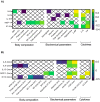Systemic Inflammation in Oncologic Patients Undergoing Systemic Treatment and Receiving Whey Protein-Based Nutritional Support
- PMID: 38892006
- PMCID: PMC11171732
- DOI: 10.3390/ijms25115821
Systemic Inflammation in Oncologic Patients Undergoing Systemic Treatment and Receiving Whey Protein-Based Nutritional Support
Abstract
There is increasing evidence about the role of inflammation in sarcopenia and tumor progression; thus, its modulation would represent a valuable strategy for improving clinical outcomes in patients with cancer. Several studies have reported that whey protein has significant anti-inflammatory and antioxidant characteristics in humans. We aimed to evaluate the effects of whey protein-based oral nutritional support on circulating cytokines in patients with solid tumors undergoing systemic treatment. Forty-six patients with solid tumors of different origin and undergoing systemic treatment were evaluated. Nutritional support with two daily whey protein-based oral supplements was administered. Circulating levels of IL-6, IL-8, IL-10, MCP-1 and IP-10 were determined. Nutritional evaluation included anthropometric, instrumental and biochemical parameters. Over 63% of the evaluated patients underwent surgery, 56.5% required chemotherapy and almost 50% received combined treatment. Patients with resected primary tumor presented with lower baseline IL-6 (p < 0.05) and IP-10 (p < 0.001); after three months of nutritional support, they presented with lower IL-8 (p < 0.05) and tended to present lower IL-6 and IP-10 (p = 0.053 and 0.067, respectively). Significant positive correlations between circulating cytokines, C-reactive protein and ferritin were observed; similarly, negative correlations with anthropometric and biochemical nutritional parameters were noticed (p < 0.05). We did not observe significant changes in circulating cytokine levels (IL-6, IL-8, IL-10, MCP-1 and IP-10) in patients with cancer undergoing systemic treatment after three months of nutritional support with whey protein-based oral supplements. According to a univariate analysis in our cohort, circulating IL-8 was associated with mortality in these patients, additionally, MCP-1 and IP-10 tended to correlate; but an age- and sex-adjusted multivariate analysis revealed that only baseline MCP-1 was significantly associated with mortality (OR 1.03 (95% CI: 1.00-1.05)). In conclusion, surgery of the primary solid tumor and combination treatment allow significant reduction in circulating cytokine levels, which remained stable while patients received nutritional support with whey protein-based oral supplements over three months. The role of MCP-1 as an independent factor for mortality in these patients should be further evaluated.
Keywords: cancer; cytokines; inflammation; whey protein.
Conflict of interest statement
The authors have no conflicts of interest to declare.
Figures






Similar articles
-
Nutritional Support Reduces Circulating Cytokines in Patients with Heart Failure.Nutrients. 2024 May 27;16(11):1637. doi: 10.3390/nu16111637. Nutrients. 2024. PMID: 38892570 Free PMC article. Clinical Trial.
-
Standard Hypercaloric, Hyperproteic vs. Leucine-Enriched Oral Supplements in Patients with Cancer-Induced Sarcopenia, a Randomized Clinical Trial.Nutrients. 2023 Jun 12;15(12):2726. doi: 10.3390/nu15122726. Nutrients. 2023. PMID: 37375630 Free PMC article. Clinical Trial.
-
Thirteen weeks of supplementation of vitamin D and leucine-enriched whey protein nutritional supplement attenuates chronic low-grade inflammation in sarcopenic older adults: the PROVIDE study.Aging Clin Exp Res. 2019 Jun;31(6):845-854. doi: 10.1007/s40520-019-01208-4. Epub 2019 May 2. Aging Clin Exp Res. 2019. PMID: 31049877 Free PMC article. Clinical Trial.
-
Whey Protein, Leucine- and Vitamin-D-Enriched Oral Nutritional Supplementation for the Treatment of Sarcopenia.Nutrients. 2022 Apr 6;14(7):1524. doi: 10.3390/nu14071524. Nutrients. 2022. PMID: 35406137 Free PMC article. Review.
-
Effect of whey supplementation on circulating C-reactive protein: a meta-analysis of randomized controlled trials.Nutrients. 2015 Feb 9;7(2):1131-43. doi: 10.3390/nu7021131. Nutrients. 2015. PMID: 25671415 Free PMC article. Review.
Cited by
-
Natural Food Components as Biocompatible Carriers: A Novel Approach to Glioblastoma Drug Delivery.Foods. 2024 Sep 4;13(17):2812. doi: 10.3390/foods13172812. Foods. 2024. PMID: 39272576 Free PMC article. Review.
References
-
- Il’yasova D., Colbert L.H., Harris T.B., Newman A.B., Bauer D.C., Satterfield S., Kritchevsky S.B. Circulating levels of inflammatory markers and cancer risk in the health aging and body composition cohort. Cancer Epidemiol. Biomark. Prev. 2005;14:2413–2418. doi: 10.1158/1055-9965.EPI-05-0316. - DOI - PubMed
MeSH terms
Substances
Grants and funding
LinkOut - more resources
Full Text Sources
Medical
Research Materials
Miscellaneous

